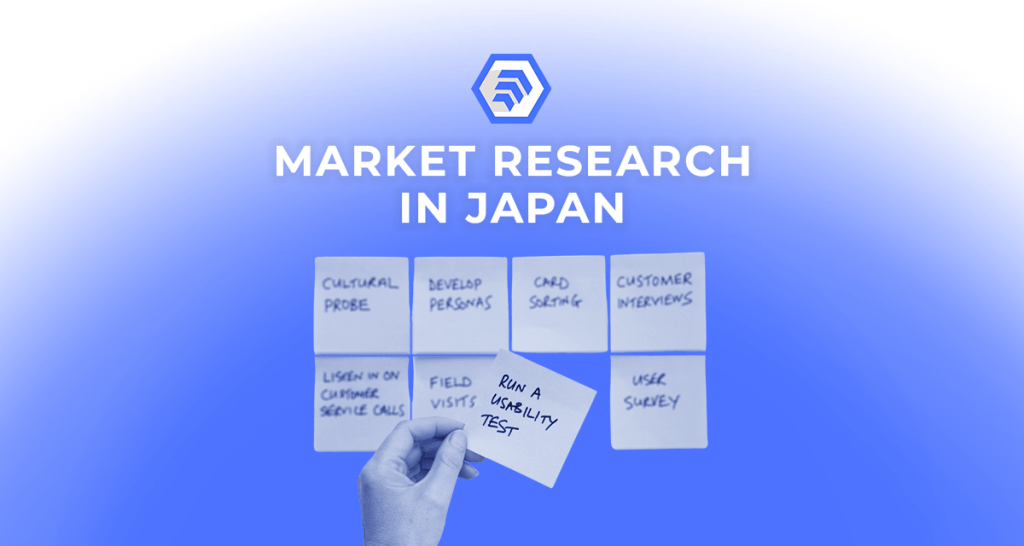Introduction
With a population of over 126 million and a highly competitive economy, Japan’s market is among the biggest and most significant in the world. For businesses trying to enter or expand in the market, the nation’s distinctive cultural and economic climate can be challenging for business expansion and operation.
Market research in Japan, in particular, can assist companies in addressing some of the distinctive difficulties faced by the Japanese market, such as cultural differences, intricate regulations, and a fiercely competitive business climate. In a market where patronage and reputation are highly prized, understanding consumer preferences and habits is also essential. This is highly important especially for foreign businesses that are targeting Japan market entry. More will be discussed in the following section.
- Introduction
- Definition of Market Research
- Importance of Market Research in Japan
- Types of Market Research in Japan
- Market Research Techniques in Japan
- Steps Involved in Conducting Market Research in Japan
- Challenges in Conducting Market Research in Japan
- Market Research Companies in Japan
- Future of Market Research in Japan
- Conclusion
Definition of Market Research
Gathering, evaluating, and interpreting data about a market, including its clients, rivals, and market trends, is known as market research. The objective of market research is to offer firms information that will help them make decisions about marketing, product development, and overall business strategy. Surveys, interviews, focus groups, and other methods can be used to perform market research, which can use both quantitative and qualitative methodologies. Businesses can better understand their target consumers, spot market possibilities, and create plans to boost their competitiveness and profitability by performing market research.
Importance of Market Research in Japan
Market research in Japan is crucial for businesses operating in the country for several reasons:
Understanding the Market: Japan’s culture is distinct, and its market dynamics may be different from those of other nations. Businesses can better understand the needs, tastes, and habits of Japanese consumers through market research in Japan, as well as the industry’s trends and competitors. For example, Japan already has very powerful beverage companies such as Kirin, Asahi, Suntory, Sapporo, Calpis, Itoen, and it’s particularly difficult to bring a new brand of beverage here outside of working with them.
Identifying Opportunities: Businesses can find untapped markets and new trends by doing market research in Japan. This can assist them in creating new goods and services that are tailored to the unique requirements of the Japanese market. Tailoring your products or services according to your target market is very important so that you can make sure that it is going to work. In Japan, it is important to do product market fit analysis as the Japanese consumer is complex and can be tricky. This will also make sure that you can make product adjustments to better suit your target market. Timothy Connor, founder and manager of Synnovate, discussed this on his product market fit episode on the Scaling Japan Podcast.
Mitigating Risks: Market research in Japan can assist companies in reducing the risks involved in entering a new market. Businesses can prevent costly mistakes and decide on product development and marketing strategies with knowledge of the market dynamics and consumer preferences. This is especially important when doing a market entry to Japan. You can check our article about Japan market entry here.
For instance, In Japan, as opposed to other countries, your product’s ingredients must be on the approved list rather than not being on the banned list. This seemingly unimportant detail could have a significant effect on your company. An article from Japan Living Guide talks about additive regulations on pre-packaged food, which is one of the best examples.
Improving Business Performance: Market research in Japan offers useful information that firms can use to boost their profitability and competitiveness. Businesses may create customized marketing initiatives, enhance client interaction, and improve pricing strategies by analyzing the market. By conducting market research in Japan, businesses can determine which marketing strategies to use when doing business in Japan. They may consider digital marketing or traditional marketing depending on the area that they’re targeting or the consumer target. To learn more about digital marketing in Japan, you can read our article here.
Guide to Digital Marketing in Japan
Types of Market Research in Japan
Businesses can carry out many kinds of market research in Japan to learn more about their target consumers, rivals, and market trends. Primary research and secondary research are the two basic subcategories of market research. While secondary research involves the analysis of already-existing data from external sources, primary research is gathering fresh data directly from clients or potential customers. Businesses can utilize a variety of research techniques within these categories, including surveys, interviews, focus groups, qualitative research, quantitative research, and observations. For organizations wishing to obtain a deeper understanding of the Japanese market and make wise business decisions, understanding the various types of market research is crucial.

Primary research
Qualitative Research:
A major research technique that tries to acquire a thorough grasp of consumer attitudes and behaviors is qualitative research. This research methodology helps delve into complex, ethereal issues and locate underlying motives and preferences. Among the qualitative research techniques are:
Focus Groups: In Japan, focus groups are a typical qualitative research technique. They entail gathering a small group of individuals to talk about a particular subject or item. Focus groups can be held in-person or online, offering insightful information about consumer views and behavior.
In-depth Interviews: Another qualitative research technique employed in Japan is in-depth interviews. They entail speaking with consumers one-on-one in order to learn more about their requirements and preferences. Whether formal or unstructured, interviews can be performed in person, over the phone, or online.
Ethnography: To understand consumer’s habits and preferences, ethnography includes studying them in their natural settings. Finding new business prospects and comprehending cultural differences are two areas where this research methodology is especially helpful.
Quantitative Research:
A key research technique that tries to measure customer attitudes and behaviors is quantitative research. This research approach helps test hypotheses and find trends and patterns in huge datasets. Among the quantitative research techniques are:
Surveys: In Japan, surveys are a popular quantitative research technique. They entail a sequence of inquiries concerning the preferences, actions, and attitudes of the customers. Open-ended and closed-ended surveys can both be completed online, over the phone, or in person. We will dive deeper into this type of quantitative research in the following section.
Observations: In Japan, observations may also be employed as a quantitative research technique. They entail watching clients in actual environments to learn about their actions and preferences. Understanding how customers engage with goods and services in their natural environment is a key benefit of this research methodology. More of this is on the techniques of market research in Japan section below.
Examples in Japan:
Focus groups are one method of primary research used in Japan to learn more about consumer sentiments regarding particular goods or services. For instance, a business can hold a focus group to discover the reasons why a certain product is not doing well in Japan’s market and to pinpoint areas for development.
The use of surveys to understand consumer preferences and behavior is another instance of primary research in Japan. For instance, a business might carry out a survey to learn how Japanese consumers use social media and to find openings for niche marketing initiatives. One best example of a company that does this is Rakuten Insight. Rakuten is a trusted research partner in Asia for market research. They ask people online to answer surveys for them and the members of the sample get points that they can cash out when a certain number is hit.
Andrew Edsall of Great Wave clearly differentiates the two types of research in his podcast episode about market research in Japan, you can watch the highlight here.
Secondary Research
Internal Sources:
Internal sources of secondary research refer to data that businesses have already collected and compiled for their use. This type of research is often readily available and can be used to inform business decisions. Internal sources of secondary research include:
Sales Data: Customer behavior can be better understood by looking at sales data, which can reveal which products are selling well and which are not. Businesses can use this information to find market trends and openings.
Customer Feedback: Surveys and other forms of customer feedback can reveal information about a customer’s preferences and level of satisfaction. Businesses can use this information to discover areas for improvement and create new goods and services.
Financial Reports: Revenue and profit margins are just two examples of the performance indicators that financial reports can offer. Businesses can use this information to pinpoint areas for development and to make wise financial choices.
Examples in Japan:
In Japan, using sales data to spot market trends is an example of internal secondary research. For instance, a business may examine sales data to determine which products are and are not popular in Japan. The corporation can use this information to create new items that are specifically suited to the Japanese market. An article from Nippon.com about department store sales recovery is a good example of data which businesses can use to check market trends and to know the status of, say, the retail industry. This type of data can be sourced internally or can be taken from external sources which will be discussed below.
Customer feedback is another instance of internal secondary market research in Japan that is used to pinpoint areas that need improvement. For instance, a business might look at consumer feedback to figure out why a certain product is not doing well in Japan and to pinpoint areas for development. AsahiNet uses a customer satisfaction survey technique to determine the level of service they provide to their customers and what could be done to improve their performance.
External Sources:
Data that businesses collect from sources outside of their organization is referred to as external sources of secondary research. Businesses can benefit greatly from this kind of research’s insights into market and sector trends. Secondary research from outside sources includes:
Industry Reports: sector studies include information on trends in the sector, including market size and growth rates. These studies can aid companies in locating market opportunities and forming sensible business judgments.
Government Reports: Government publications shed light on Japan’s economic situation and regulatory landscape. Businesses can use this information to better understand their industry and make strategic decisions.
Academic Research: Academic research sheds light on consumer choices and behavior. Businesses can use this information to better understand their target market and create more successful marketing campaigns.
Examples in Japan:
Japan’s usage of industry reports to identify market trends is an example of external secondary research. For instance, a business can read an industry report to comprehend the scope and rates of expansion of the Japanese market for a specific product. This information can assist the business in locating market opportunities and creating efficient marketing plans. An example of an industry report that businesses can take advantage of is this article from Fitchsolutions about the acceleration of Japan’s growth in 2023.
The utilization of government papers to comprehend the regulatory environment is another instance of external secondary market research in Japan. For instance, a business might study a government report to comprehend the rules governing a specific industry in Japan. By using this information, the firm may comply with rules and make wise business decisions. An example would be the Japanese government’s interim report on the digital advertising markets.
Market Research Techniques in Japan

A variety of approaches and instruments are utilized in market research in Japan to gather and analyze market data. These methods may consist of both primary (such as surveys and focus groups) and secondary (such as industry reports and government statistics) research. Businesses in Japan can learn a lot about consumer behavior, market trends, and other things that might help them make wise business decisions by adopting these strategies. The precise demands and objectives of the company, as well as the resources available to perform the study, will determine the method of market research in Japan to be used. The following techniques were briefly mentioned above as types of quantitative/qualitative research, below we will discuss them as effective techniques to employ in doing market research in Japan.
Surveys
Surveys are a well-liked method of gathering information from the target market or consumer directly. There are several ways to conduct surveys, including online, over the phone, by mail, or in person. Survey data can offer important insights into customer behavior, preferences, and opinions. The survey’s findings can be examined to find patterns, openings, and potential problems that Japanese companies can utilize to inform their actions.
Surveys are a popular method of market research in Japan, especially when learning more about consumer preferences and behavior. Due to the rising number of internet users in Japan, online surveys are becoming more and more common. Another well-liked method for gathering information from a big and diverse audience is through telephone surveys.
In order to properly conduct surveys in Japan, it is crucial to consider linguistic and cultural barriers. Surveys should be created using terminology that is suitable and sensitive to cultural differences. To prevent misunderstandings and errors, the questions should be crystal clear, succinct, and simple to grasp.
It is crucial to use a representative sample of the target audience in surveys conducted in Japan to guarantee the authenticity and quality of the data obtained. Random sampling or stratified sampling techniques can be used to accomplish this.
As mentioned above, Rakuten Insights is the best example of this kind of marketing research technique.
Struggling To Close Sales in Japan?
Interviews
A qualitative market research technique known as an interview entails one-on-one conversations between a researcher and a participant. In-person, telephone, and video conference interviews are all options. Gaining in-depth insights into the participant’s attitudes, ideas, and experiences connected to a certain topic or product is the aim of interviews.
Interviews are frequently used in market research in Japan to elicit in-depth information about participants’ thoughts and experiences. In Japan, face-to-face interviews are a common choice, especially when working with persons who are older or less accustomed to technology.
Understanding cultural norms and traditions is crucial while conducting interviews in Japan. For instance, it is important in Japanese culture to utilize the honorific language “keigo”, especially when conversing with senior citizens or persons in higher social positions. Additionally, it is critical to be aware of nonverbal cues like eye contact and bowing since they might communicate crucial cultural cues.
It is crucial to use a representative sample of the target audience in order to guarantee the accuracy and validity of the data gathered through interviews in Japan. In order to guarantee that the interview questions are clear, open-ended, and focused on the research objectives, researchers should carefully design them.
Focus Groups
Focus groups are a form of qualitative market research technique where participants debate a particular subject or item in a group setting with the assistance of a moderator. Focus groups are intended to obtain in-depth information on participants’ attitudes, beliefs, and experiences, on things like brand-new goods or ad campaigns. Focus groups are frequently held in person and can have between 5 and 10 people.
Cultural nuances must be taken into consideration when holding focus groups in Japan. One of the biggest challenges in holding focus groups would be participants being reluctant to voice dissent or express negative opinions due to cultural emphasis on group cohesion. To get more accurate results, the moderator must be adept at controlling group dynamics and making sure that everyone feels free to voice their ideas.
It is crucial to use a representative sample of the target audience in focus group data collection in Japan to guarantee its validity and accuracy. Additionally, the moderator should carefully craft the focus group questions to make sure they are precise, open-ended, and targeted at the study’s goals.
Focus groups are an efficient kind of market research in Japan that can give organizations important information about consumer attitudes and preferences. Businesses can use focus groups to better understand their target market and make defensible choices regarding product development and marketing tactics.
To know more about selling in Japan from the maker to the market, consider reading our Insider Guide on Selling Products in Japan.
Observations
A kind of technique in market research in Japan known as observations entails watching and documenting consumer behavior in its natural setting. This can involve watching customers use a product or engage with a brand, or just watching customers behave in a certain setting, like a store or shopping center.
In order to learn more about consumer behavior and preferences, market researchers frequently employ observations in Japan. Researchers might, for instance, watch how users engage with things in a store or how they move across a website or mobile app. Observations can also be utilized to learn about cultural customs and behaviors that might influence customer choice.
It is crucial to be mindful of cultural quirks and customs when doing observations in Japan. For instance, Japanese consumers may value different product features than consumers in other countries or may have different expectations when it comes to customer service. Assumptions about customer behavior based on cultural stereotypes should be avoided in order to respect cultural norms.
It is crucial to use a representative sample of the target audience in order to guarantee the quality and accuracy of the data gathered through observations in Japan. To establish consistency between various observations, researchers should employ standardized measurement techniques and thoroughly record their findings.
Digital marketing aalso serves as a powerful strategy for comprehensive market research in Japan through our guide on Digital Marketing in Japan. Whether you’re a seasoned marketer or new to the Japanese market, our resource offers essential insights and strategies to harness the potential of digital marketing as a tool for gathering valuable market insights.
Steps Involved in Conducting Market Research in Japan
- Define the research objectives: Clearly defining the study objectives is the first stage in conducting market research in Japan. This entails determining the issue or window of opportunity that the study is meant to address, as well as the precise queries that the study should address.
- Choose the research method: The proper research method should then be chosen after the study objectives have been established. In order to do this, you might undertake primary research (such as surveys, interviews, or focus groups) or secondary research (such as looking at industry reports or official statistics).
- Develop the research plan: The following stage is to create a research plan after the research methodology has been decided upon. This entails choosing the research tools (such as survey questions or interview guides) and the sample size and composition, as well as creating a timeframe for the study.
- Collect the data: Implementing the research strategy and gathering information from the target market are both part of the data collection process. Depending on the research method selected, this can involve conducting surveys, interviews, focus groups, or observations. Below is another highlight from our podcast episode with Andrew Edsall on market research in Japan mentioning the effective questions to ask when conducting market research.
- Analyze the data: The next step after gathering the data is to analyze it. To find patterns, trends, and insights, the data must be organized and summarized. Data analysis may incorporate statistical approaches, content analysis, or other qualitative or quantitative methodologies, depending on the study methodology selected.
- Draw conclusions and make recommendations: Making conclusions based on the data analysis and business recommendations is the last stage of market research in Japan. This could entail finding areas for product development, enhancing marketing tactics, or enhancing customer service.
Challenges in Conducting Market Research in Japan
For companies trying to enter new markets, market research in Japan is a crucial tool, and doing it in the complex market might bring particular difficulties. The following are some of the main difficulties that companies could experience in Japan when performing market research in Japan:
Language barriers: Many Japanese consumers might not be fluent in English because Japan is a country with a distinctive language and culture. Because of this, it may be challenging for firms to conduct surveys or interviews in English. To get around this problem, they may need to hire local researchers or translators.
Cultural differences: Japanese culture has its own traditions, rituals, and social mores that may influence how consumers behave and what they desire. It is crucial for organizations to be aware of these cultural differences and take them into consideration when conducting market research in Japan because they may make it challenging to evaluate market research findings.
Lack of data availability: In several areas, Japan’s data availability is relatively constrained when compared to other affluent nations. For instance, it could be challenging to target particular demographic groupings or comprehend consumer preferences due to a lack of accurate demographic or consumer behavior data.
Limited access to consumers: It can be challenging to get access to consumers for market research in Japan because of the market’s fierce competition. It may be difficult to get consumers to take part in surveys or interviews, which can make it difficult to collect reliable data.
Cost: It can be expensive to perform market research in Japan, particularly if companies choose primary methods like surveys or focus groups. The cost of market research may increase due to the high cost of living in Japan and the requirement for qualified local researchers or translators.
Despite these difficulties, market research can offer useful insights for companies doing business in Japan. Businesses can get through these obstacles and learn more about the Japanese market by engaging with knowledgeable local researchers and accounting for cultural variations.
Market Research Companies in Japan

Companies that conduct market research in Japan are crucial in giving firms the data they require to decide whether to enter or grow in the Japanese market. Here is a summary of the main market research firms in Japan, together with information on the services they offer and how to pick the best firm for your requirements.
Major Market Research Companies in Japan
There are several major companies that conduct market research in Japan, including
INTAGE: One of the biggest market research firms in Japan, INTAGE provides a variety of services including market analysis, consumer surveys, and consulting.
Macromill: Another significant market research firm in Japan is Macromill, which specializes in data analytics, social media research, and online surveys.
Nippon Research Center: Leading market research and consulting company in Japan, Nippon Research Center offers research services in fields like marketing strategy, product development, and consumer satisfaction.
Yano Research Institute: Leading market research and business intelligence company in Japan, Yano Research Institute provides research services in industries like IT, healthcare, and retail.
Great Wave: The company has over 20 years of hands-on experience in Japan and covers the areas in qualitative market research, quantitative market research, and Japan market entry consulting.
Services Provided by Market Research Companies in Japan
Companies that conduct market research in Japan offer a range of services to help businesses gain insights into the Japanese market. These services may include:
Consumer surveys: To learn more about consumer preferences, behavior, and attitudes regarding goods or services, market research firms can conduct surveys.
Market analysis: Companies can offer competitive intelligence and market analysis to help organizations understand industry trends, spot opportunities, and make wise decisions.
Consulting services: For organizations looking to increase customer happiness, launch new goods, or establish marketing strategy, market research firms may provide consultancy services.
Data analytics: Numerous market research firms in Japan focus on data analytics, employing cutting-edge methods to examine vast volumes of data and offer insights into industry trends and customer behavior.
Choosing a Market Research Company in Japan
When choosing a market research company in Japan, there are several factors to consider, such as:
Expertise: Look for a company with experience in your industry or market segment.
Reputation: Check the company’s reputation and track record, including customer reviews and case studies.
Resources: Make sure the company has the resources necessary to conduct market research in Japan, including access to a network of participants and experienced researchers.
Cost: Consider the cost of the services provided by the company and how they fit into your budget.
Japanese market research firms are crucial in giving businesses knowledge of the Japanese market. Businesses can get a competitive edge in Japan by being aware of the services offered by market research firms, the key players in the industry, and how to pick the best firm for their requirements.
Future of Market Research in Japan
The future of market research in Japan is expected to be shaped by several factors. First, we need to consider the technological advancements in data collecting and analysis that Japan will need to adjust to. This comes as a result of the growing usage of digital technology and social media.
Second, Japan’s market is growing towards customized research. As the demand for product development and market segmentation becomes more specialized, businesses in Japan will have to turn more and more to customized research services.
Third, Market research firms in Japan will need to pay attention to sustainability in their businesses. They have to begin incorporating sustainability into their research procedures and offer insights into consumer preferences connected to sustainability as a result of increased concerns over environmental and social issues.
Finally, easier access to expanding into Japan will be available as market research firms in Japan will need to serve companies wishing to enter or expand in the Japanese market as Japan continues to draw foreign investment and increase its worldwide influence.
Conclusion
For organizations trying to enter or grow in the Japanese market, market research in Japan is essential. Market research assists companies in making educated decisions and gaining a competitive advantage in Japan by offering insights into customer behavior, market trends, and competitive intelligence. As the sector continues to develop and adapt to shifting market conditions and consumer tastes, the future of market research in Japan is also crucial.
For more information on market research in Japan, listen to Andrew Edsall as he discusses more details on episode 30 of the Scaling Japan podcast.










